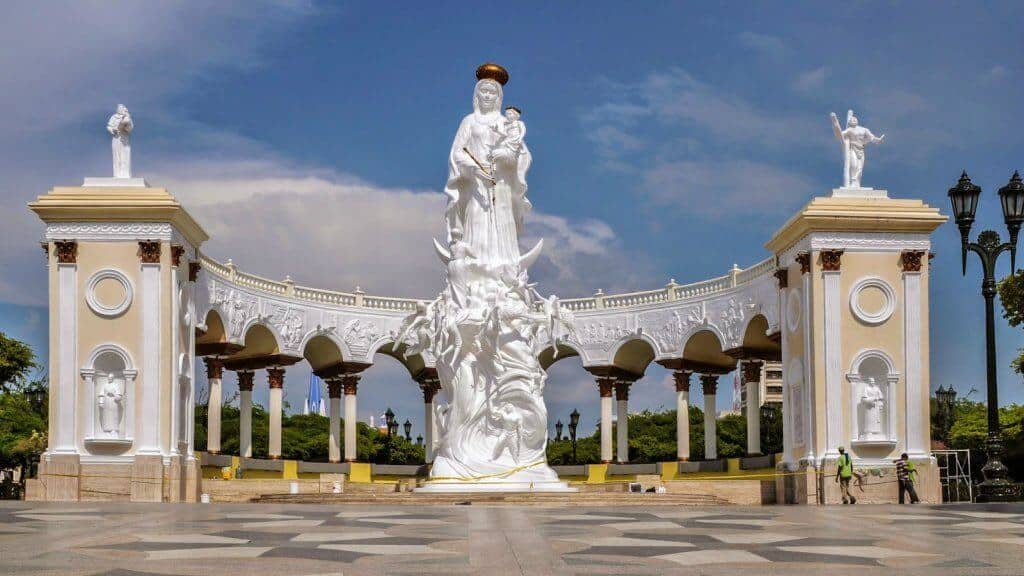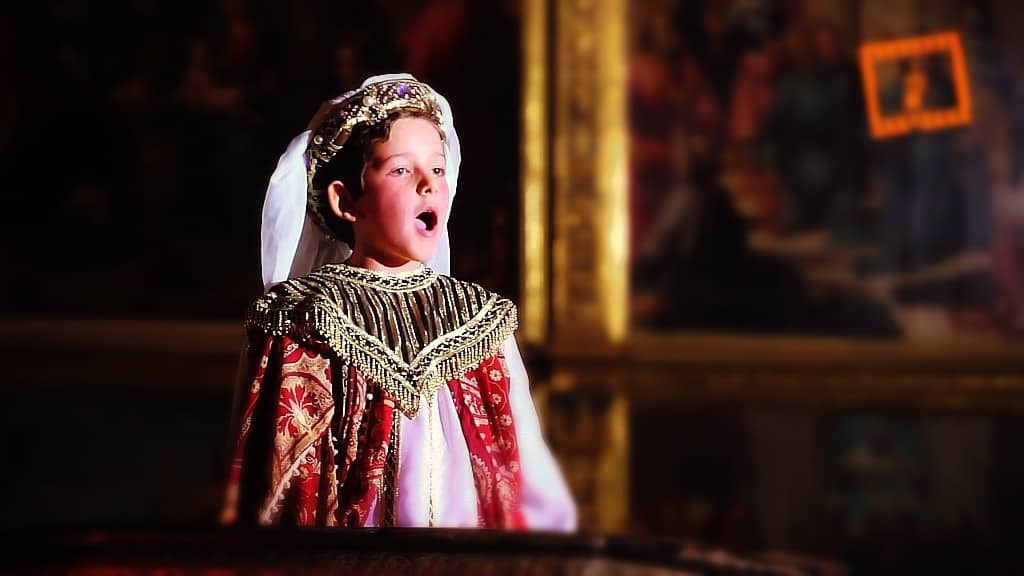She has earned the title of the Lady of El Saladillo for her deliberate choice to reside amidst the marginalized members of society, including individuals of mixed race heritage, young children of color, skilled craftsmen and the laborers who serve the affluent owners of the Plaza Mayor.
Our Lady of Chiquinquirá – November 18 – Zulia State, Venezuela
In El Saladillo de Maracaibo a small town nestled between bustling streets and salt pans by the lake stood an ancient hermitage where San Juan de Dios was venerated. The houses of Saladillo were adorned with beautiful gates and vivid colors.
The people of Saladillo gave all of their diamonds to crown the hermitage after helping to build a grand and impressive temple. They referred to it as their Queen. However, one day the houses of Saladillo were destroyed their parks razed and the spirit of the city crushed.
Then the Virgin remained alone in the great basilica that the dispossessed, mulattos, and Negritos—grandparents, parents and children of El Saladillo—had built. She was also known as the Queen of La Guajira by the Wayúu people.
For centuries, the Virgin of the Rosary has reigned. She appeared to a monk named Domingo de Guzmán in a small Portuguese village called Fatima in 1208. In her hand, she carried a rosary. She instructed him on its use and asked him to impart it to others.
Before a conflict, Domingo taught it to the men of Simon IV de Montfort. It is said that the rosary was decisive in the victory of the Catholic army and Montfort built the first chapel in honor of the image as a sign of gratitude. She also reigns in Colombia. After performing numerous miracles, Mary was formally named patron of that nation by order of July 18th, 1829.
Discovering the History of the Virgin of the Rosary: From Sutamarchán to Chiquinquirá.
The story of the Virgin of the Rosary begins in the settlement known as Sutamarchán. The Virgin of the Rosary was painted for the chapel of the encomendero Antonio de Santana around 1562 by a silversmith from Tunja, another small Colombian town.
The coarsely woven cotton blanket served as a canvas for the painting. He then extracted the colors for the painting of the flowers, fruits, roots and earth, combining them with egg whites in a process known as tempera. The Virgin Mary is still accompanied by Saint Andrew the Apostle to this day, while Saint Anthony of Padua is painted to the left of the Virgin, as the canvas was wider than long.
First of all, to thank Dominican priest Andrés de Jadraque for his recommendation and secondly to commemorate the encomendero known as Juan. The rainwater from the straw roof was damaging the work until its images lost definition and became blurred. The painting was eventually returned to its owner and moved to the checheres room of an old chapel in Chiquinquirá approximately 1578.
Xequenquirá: The Indigenous “Place of Worship of the Gods” in Colombia with a Miraculous Virgin Mary Portrait
The indigenous language for referring to the “place of worship of the gods” is Xequenquirá. This small settlement is located in the Sarabita Valley, near Boyacá, in a hollow shrouded in mist and swamps, where rich terebinth tree forests thrive which produces turpentine.
The terebinth is mentioned three times in the Old Testament. Mara Ramos the aunt of the elderly encomendero, had kept the image and took it to a small sanctuary at the family property of Chiquinquirá. The Virgin Mary seemed to emerge from the canvas, full of light when the portrait was illuminated one morning, its faded colors came to life. An indigenous woman who was talking to her at the time saw it as did her little son, who shouted:
—Mother, mother, why is the Virgin sitting on the ground? Her first miracle took place in Colombia.
Devotees of the Our Lady of Chiquinquira
The fishermen and sailors of Maracaibo were the first devotees of the Virgin of Chiquinquirá, as their boats and canoes did not set sail without her image onboard.
The Virgin of Chiquinquirá along with her crescent moon, mantle, rosary and child, made the journey to Zulia by boat. She traveled from the rivers of Colombia crossing the lake aboard a vessel carrying goods to ports in other continents traversing oceans to arrive there. This journey took place two hundred years later.
According to some accounts, this 16th-century painting was allegedly stolen by pirates during one of their raids on Colombian ports. At that time washerwomen were busy cleaning their clothes on the shore of the sea, witnessing the constant arrivals and departures of boats and bandits engaged in the bustling Maracaibo commerce.
Discovering the Colored Virgin of the Rosary of Chiquinquirá: The Story of Maria Cárdenas
Maria Cárdenas, a resident of Maracaibo situated between Venezuela and Ciencias streets, discovered a small board floating in the sea while she was working. Initially, she used it as a lid for her jar, but a few days later, she noticed drawings appearing on it.
Curious, she hung it on her wall and was amazed when three images – a Virgin and child mounted on a half-moon and two saints on each side – lit up on the small square. The colors of ochres and sepias, created with natural materials and tempera, came alive and highlighted their hues. This was the colored Virgin of the Rosary of Chiquinquirá, which was born on the 18th of November 1709 at dawn.
“The Story of the Virgin of Zulia, Chinita: A Tale of Miracles and Adoration in Maracaibo”
The beginning of her fame and neighborhood adoration was marked by the cries of “Miracle! Miracle!” from the old woman on that day, which soon spread beyond its limits. In honor of her, Maracaibo decided to move her portrait to the Iglesia Mayor also known as the Iglesia de San Pedro y San Pablo, the city’s Cathedral.
However, the tombstone became too heavy to move during the procession. Suddenly a voice suggested that she wished to travel to St. John of God and the crowd shifted to the right causing the weight to become as light as flower petals.
Since then, the Zulian sovereign, neighbor and solitary of El Saladillo has resided there an enthroned monarch from her own secular history and passion. During his visit to Maracaibo Pope John Paul II saw her and recognized her as the Virgin of Zulia or Chinita.
Related post




